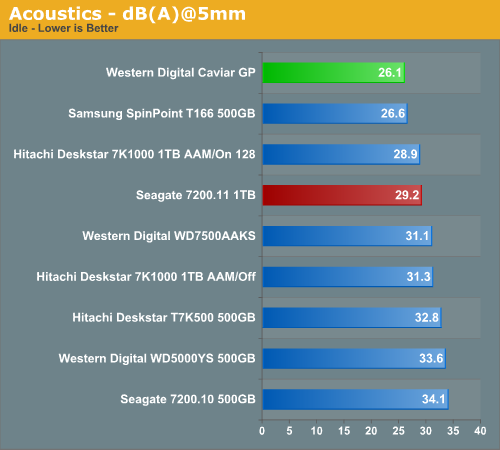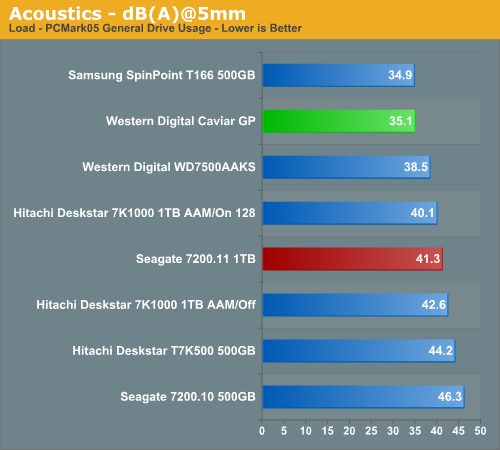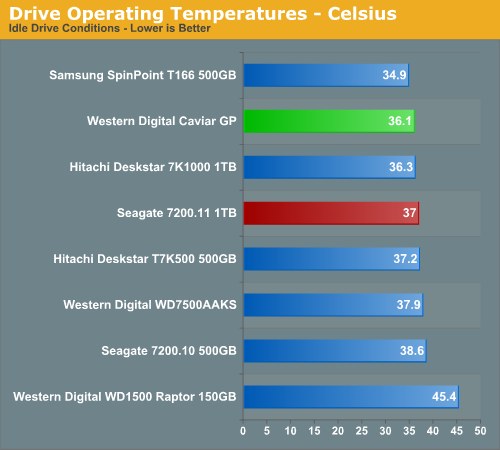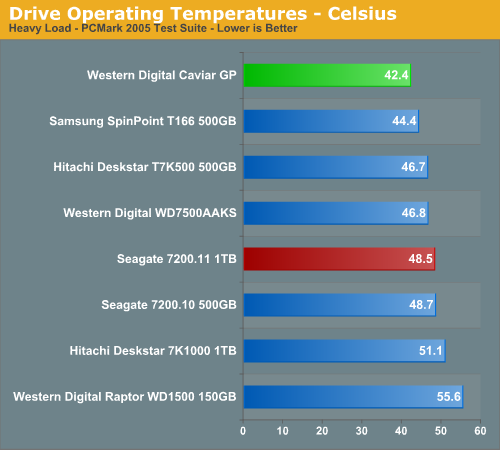Seagate and Western Digital 1TB Drives: Improved and Green
by Dave Robinet on November 26, 2007 7:00 AM EST- Posted in
- Storage
Acoustics
Our test methodology for acoustics has changed. Rather than checking the drive inside the case with components, we use an external USB-SATA converter cable to run the drive to a different physical room to take our measurements. While the conversion to USB does reduce the performance level of the drive during the test, it leaves the noise characteristics unchanged. The drive sits atop a small brick of acoustical sponge material to keep it raised from the floor without introducing additional vibration. We take measurements at a distance of 5mm from the rear and front of the drive. These precautions, whose results on earlier drives confirm the accuracy of our previous methodology, will further reduce the likelihood of ambient noise from the PC interfering with our results.
Our acoustic tests measure the decibel levels while the system is at idle and under load while running the General Hard Disk Drive Usage benchmark within PCMark 2005. We found through trial and error that this particular benchmark produces controlled readings across a wide range of applications within the benchmark. This particular benchmark utilizes 60% reads and 40% writes within the trace playback file.
We report measurements based on an A-weighted decibel score that measures frequencies similar to the way the human ear responds to sound. We take three measurements for each test. We then subtract the high and low scores and arrive at our findings by reporting the remaining score. The test room has a base acoustical level of 20dB(A).


The idle noise level of the Caviar GP is impressive, owing to the lower rotational speed of the drive due to its power saving technology. At load, however, the drive is slightly louder than the Samsung T166. The Seagate 7200.11 drive turns in middling results in both tests.
Thermals
Our thermal tests utilize sensor readings via the S.M.A.R.T. (Self-Monitoring, Analysis and Reporting Technology) capability of the drives as reported by utilizing the Active SMART 2.6 utility. We also utilize thermal sensors and infrared measurement devices to verify our utility results. We test our drives in an enclosed case environment without the fans operational to simulate temperatures that conceivably exists in a near-silent SFF or HTPC case design. We typically find the reported numbers drop anywhere from 14% to 25% with the case fans operational. Our base temperature level in the room at the time of testing is 25C.


Here is where we see the Caviar GP shine. The temperature reading of 42.4C under load is the coolest conventional drive we have tested, coming in even cooler than the Samsung T166. The Seagate 7200.11 produces comparatively little heat at idle, but warms quickly under load, finishing near the hottest drives we have tested.










31 Comments
View All Comments
darshahlu - Monday, November 26, 2007 - link
One thing I would have liked to see in the article is a RAID test. Specifically, I wonder whether or not the WD drive with its variable rotational speed will have problems in RAID configurations.In my experience with the WD drives, the answer to this question is yes. I have two of the WD Terabyte drives in a RAID MIRROR setup. The issue I noticed is that while copying data onto the mirror from multiple sources, some data becomes corrupt. I contacted WD support about the problem and am waiting to hear back from them. Perhaps it is true that these WD drives simply do not work well in a RAID setup.
Has anyone else experienced problems with the WD drives in RAID?
Darshan
darshahlu - Thursday, December 6, 2007 - link
I contacted WD about RAID support. Here is the response:Response (Jeremy H.) 12/06/2007 05:59 PM
Dear Darshan,
Thank you for contacting Western Digital Customer Service and Support.
The WD10EACS is a desktop drive. WD desktop drives do not work properly when used in a RAID array. I recommend you exchange your WD10EACS drives for the RAID model, WD1000FYPS.
Answer Title: What is the difference between Desktop edition and RAID (Enterprise) edition hard drives?
Answer Link: http://wdc.custhelp.com/cgi-bin/wdc.cfg/php/enduse...">http://wdc.custhelp.com/cgi-bin/wdc.cfg...?p_faqid...
Answer Title: Specifications for the Western Digital RAID edition Serial ATA hard drives.
Answer Link: http://wdc.custhelp.com/cgi-bin/wdc.cfg/php/enduse...">http://wdc.custhelp.com/cgi-bin/wdc.cfg...?p_faqid...
Sincerely,
Jeremy H.
Western Digital Service and Support
http://support.wdc.com">http://support.wdc.com
Zak - Monday, November 26, 2007 - link
I was hoping they'd introduce ACS (Actual Capacity Specification) with the 1TB drives so when I look in My Computer it would actually say 1 TB under Total Size instead of 930 GB. Uncool :rolleyes:Z.
JarredWalton - Monday, November 26, 2007 - link
SI has settled on TB for 1 trillion for a long time. If you want 2^40 bytes, you'll need TiB (tebibyte). While computers have been using Kilo, Mega, Giga, Tera for a long time, the fact is that those were originally designated as 1000, 1000000, 1 billion, 1 trillion, etc. before computers began using the abbreviations. Computer scientists were lazy (as usual - I can say that because I studied CS) and simply used Kilo for 1024 because it was "close enough".As far as I'm concerned, "ACS" has been in use for a long time; now we just need to get operating systems and users to understand the correct meaning of SI prefixes. :)
Chadder007 - Monday, November 26, 2007 - link
What...no check on wattage usage on the drives? If its a "green" drive id like to know how much power its actually saving.nowayout99 - Monday, November 26, 2007 - link
Ditto. I was expecting to see some sort of power draw comparison, afterall the one drive is marketed as being "green."Instead, we're asked to take their word for it.
drebo - Monday, November 26, 2007 - link
Why is it that almost every single article Anandtech puts out has a conclusion that contradicts their own test results?Seriously. If the two drives are so different and so suited for different purposes, why are you even comparing them? If it's just to say that the WD drive excells at being green and the Seagate drive sucks at performance, why even bother with an article?
You cannot judge the drives solely on the merits of the competition while ignoring what the drive is good at.
This right here: "the redeeming feature of the Seagate drive is only that it turns in better results than the Western Digital drive". That's a no-brainer, and anyone could have guessed that by looking at the manufacturer specs. More to the point: wasn't that the goal of the article--to find out which of the two performed better? So, why, in your conclusion, do you completely ignore the fact that the Seagate drive is clearly the better performer?
You judge the Seagate drive for not being quiet, for running hot, for having bad performance, yet you completely ignore the fact that in your little "head-to-head" comparison, it is the victor in terms of performance. By that same token, you praise the Western Digital drive for being quient, for running cool, and you completely ignore the fact that it performed worse than any other drive tested.
The bias on this site is palpable. So much for honest reviews.
yuchai - Monday, November 26, 2007 - link
Do you actually make a HD purchase decision solely based on performance?I actually liked the conclusion. Sure, the WD is slower in almost everything. But if you look at the real life benchmarks it's only about 5% in all apps except WinRAR. Is this difference high enough to offset the savings in price and power consumption? I think this is the type of question that the consumer should be asking, and the conclusion does a good job at doing just that.
Anyway, if you do not like the conclusion, you can easily look at the facts and benchmarks only and make your own call. Ultimately, AT can only give information and recommendations. The decision maker is still you.
JEDIYoda - Monday, November 26, 2007 - link
Exactly what gamer in their right mind is going to be using that 1T for gaming anyways??Things that make you go hmmm....
JarredWalton - Monday, November 26, 2007 - link
This isn't just a comparison of Seagate to Western Digital, obviously. That's why there are several other hard drives listed in the benchmarks. The conclusion for the Seagate fits with the benchmarks: it is slower than (or at best equal to) the Hitachi 1TB drive in every single test. The only thing it has going for it is a five-year warranty, which doesn't count for much in my book. Sure, you can get a replacement drive for an extra two years, but until manufacturers start providing data recovery as part of the warranty I just don't think it's a big deal. I have dozens of hard drives from all the major manufacturers; granted, I'm not stressing every single drive 24/7, but drive failures are uncommon - whether in the first three years or at 4-5 years.WD has lower power (meh - 4W is *nothing* when it comes to power!), but it also has a much lower price. Seagate has a price that is $5 cheaper than Hitachi (at Newegg - though I admit I'm not sure what the difference is between the four Hitachi 1TB drives that show up). The "enterprise" version is also $25 more than most expensive Hitachi - $55 more than the cheapest 1TB Hitachi. Given the better performance (Seagate has low write performance) and essentially equal price, we'd recommend the Hitachi over the Seagate.